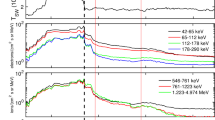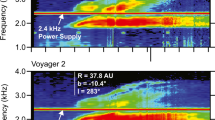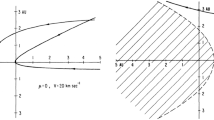Abstract
The heliospheric termination shock is a vast, spheroidal shock wave marking the transition from the supersonic solar wind to the slower flow in the heliosheath, in response to the pressure of the interstellar medium. It is one of the most-important boundaries in the outer heliosphere. It affects energetic particles strongly and for this reason is a significant factor in the effects of the Sun on Galactic cosmic rays. This paper summarizes the general properties and overall large-scale structure and motions of the termination shock. Observations over the past several years, both in situ and remote, have dramatically revised our understanding of the shock. The consensus now is that the shock is quite blunt, is with the front, blunt side canted at an angle to the flow direction of the local interstellar plasma relative to the Sun, and is dynamical and turbulent. Much of this new understanding has come from remote observations of energetic charged particles interacting with the shock, radio waves and radiation backscattered from interstellar neutral atoms. The observations and the implications are discussed.




Similar content being viewed by others
References
A. Balogh, J.R. Jokipii, Space Sci. Rev. 143, 85 (2009)
A.J. Barnes, J. Geophys. Res. 98, 15137 (1993)
K.V. Beard, C. Chuang, J. Atmos. Sci. 44, 1509 (1987)
L.F. Burlaga, N.F. Ness, M.H. Acuna, R.P. Lepping, J.E.P. Connerney, Science 309, 2027 (2005)
A.C. Cummings, E.C. Stone, L.F. Burlage, N. Ness, F.B. McDonald, W.R. Webber, in Proc. 28th Int. Cosmic Ray Conf., Tsukuba, Japan, vol. 7 (2003), p. 3777
R.B. Decker, S.M. Krimigis, E.C. Roelof, M.E. Hill, T.P. Armstrong, G. Gloeckler, D.C. Hamilton, L.J.Lanzerotti, Science 309, 2020 (2005)
R.B. Decker, S.M. Krimigis, E.C. Roelof, M.E. Hill, AIP Conf. Proc. 1039, 349 (2008)
J. Giacalone, J.R. Jokipii, Astrophys. J. 649, 137 (2006)
J. Giacalone, J. Jokipii, Astrophys. J. 663, 41 (2007)
J.R. Jokipii, Astrophys. J. 146, 480 (1966)
J.R. Jokipii, Astrophys. J. 631, 163 (2005)
J. Jokipii, J. Giacalone, Astrophys. J. 660, 336 (2007)
J.R. Jokipii, E.N. Parker, Phys. Rev. Lett. 21, 44 (1968)
J.R. Jokipii, J. Kóta, J. Giacalone, Astrophys. J. 611, 141 (2004)
J. Kóta, in Proceedings 30th ICRC, Merida, vol. 3 (2007), p. 231
S.M. Krimigis, R.B. Decker, M.E. Hill, T.P. Armstrong, G. Gloeckler, D.C. Hamilton, L.J. Lanzerotti, E.C. Roelof, Voyager 1 exited the solar wind at a distance of 85 au from the sun. Nature 426, 45 (2003)
R. Lallement, E. Quemerais, J. Bertaux, S. Pheron, Science 307, 1447 (2005)
G. Li, G.P. Zank, AIP Conf. Proc. 858, 978 (2006)
F.B. McDonald, E.C. Stone, A.C. Cummings, B. Heikkila, N. Lal, W.R. Webber, Enhancements of energetic particles near the heliospheric termination shock. Nature 426, 48 (2003)
M. Neugebauer, J. Giacalone, E. Chollet, D. Lario, J. Geophys. Res. 111, 2222 (2006)
E.N. Parker, Astrophys. J. 128, 664 (1958)
R. Ratkiewicz, A. Barnes, G.A. Molvik, J.R. Spreiter, S. Stahara, M. Vinokur, S. Venkataswaran, Astron. Astrophys. 335, 361 (1998)
N.A. Schwadron, D.J. McComas, Geophys. Res. Lett. 33, 100 (2006)
E.C. Stone, A.C. Cummings, F.B. McDonald, B.C. Heikkila, N. Lal, W.R. Webber, Science 309, 2017 (2005)
Y.C. Whang, L.F. Burlaga, Y.M. Wang, N. Sheeley, Geophys. Res. Lett. 31, 33 (2004)
G.P. Zank, Space Sci. Rev. 89, 413 (1999)
Acknowledgements
This work was supported, in part, by NASA under grant SRT NNX08AH55G. I am also indebted to Joe Giacalone and Jozsef Kòta for many fruitful discussions of these topics.
Author information
Authors and Affiliations
Corresponding author
Rights and permissions
About this article
Cite this article
Jokipii, J.R. The Heliospheric Termination Shock. Space Sci Rev 176, 115–124 (2013). https://doi.org/10.1007/s11214-012-9914-0
Received:
Accepted:
Published:
Issue Date:
DOI: https://doi.org/10.1007/s11214-012-9914-0




